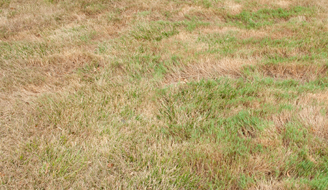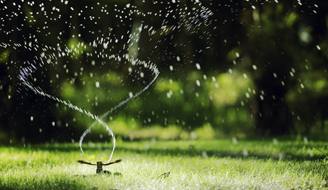Read the pesticide label carefully and be sure that you have the proper equipment for applying it safely. You will need protective clothing to protect yourself from exposure even when applying the safest pesticides. Minimally, protective gear should include rubber gloves, eye protection, a long-sleeved shirt, long pants, and closed shoes. Avoid using cotton gloves or lightweight dust masks that may absorb the spray and result in prolonged contact with your skin. Read the pesticide label carefully for additional protective requirements.
Required equipment varies according to your application site, your choice of pesticide, and your willingness to work with more complicated application devices. For many home and garden pesticide applications, the best choice is to purchase a ready-to-use product in a trigger pump type of sprayer. Ready-to-use products eliminate the need to dilute and mix pesticides or purchase special equipment and are excellent for spot treatments on small plants and shrubs. At the other end of the spectrum are compressed air sprayers, which require careful maintenance and operation as well as precise mixing of chemicals.
If you mix your own pesticides, keep a set of measuring spoons or cups for use only with pesticides. It is a good idea to write "PESTICIDE ONLY" on them to distinguish them from your kitchen utensils, and keep them well away from food preparation areas. A locked storage cabinet in a garden shed, garage, or well-ventilated utility area is the best place to store pesticides and equipment you use to mix or apply pesticides. If you are spraying for weed control, keep a sprayer specifically for that purpose and label it "WEEDS ONLY." Otherwise, herbicide residue in the sprayer may injure plants if the same sprayer is used for applying another type of pesticide or fertilizer.
Take a shower as soon after application as possible. Wash clothing separately from other laundry. Never smoke, drink, eat, or use the bathroom after pesticide application without washing first.
HOW TO DILUTE AN HERBICIDE
For most herbicides, the application rate is stated in ounces per 100 square feet or 1000 square feet, so you need to know how large an area you are treating in order to determine the amount of product to use. Suppose you are trying to kill weeds in your lawn and the herbicide label states "use 2 oz. per 1000 square feet." After measuring, you find your lawn is only 600 square feet. Therefore, you would use (600 square feet/1000 square feet) X 2 oz. = 0.6 X 2 oz. = 1.2 oz. of herbicide to treat the entire lawn.
You also must calculate how much water you need to add to your sprayer. Insecticide and fungicide labels and many herbicide labels tell you how much water to add to dilute your spray. If a certain volume of water is not listed, you can determine how much you need by spraying a small area with the sprayer and a known quantity of clean water. Then divide by the fraction of the area where you plan to apply the herbicide. For example, if you found out that one quart of water covered 100 square feet, you can assume you will need 6 quarts to cover 600 square feet. Mix your 1.2 oz of herbicide in 6 quarts of water.
MEASURING AND DILUTING PESTICIDE CONCENTRATES
Properly measuring concentrated formulations of pesticides is essential for their effective and safe use. The application rate for most insecticides and fungicides is given on the label in ounces per gallon of water used in the spray applicator. It is essential that you follow these procedures properly and dilute and apply materials as required. For herbicides and some uses of insecticides and fungicides (such as applications on lawns), the label will indicate the amount of pesticide to use for a given area. In these cases, you'll need to measure the area you are treating to calculate how much to mix up.
Remember, if the label specifies a dilution rate, you need to follow the label directions precisely. Before mixing up your pesticide, test out your sprayer with water to assure you will cover the recommended area with the recommended amount of diluted spray. If not, you will need to adjust your application rate accordingly by walking or spraying slower or faster.
Insecticide or fungicide directions for fruit or ornamental trees often don't specify areas in square feet to be treated. They often say something such as "wet plants to dripping point, thoroughly cover both sides of leaves." For these applications or for spot treatments, it is also a good idea to test out your sprayer with water to see how much spray you need to cover a fruit or ornamental tree or other area. That way you'll know how much product to mix up.
Never use more than what the directions recommend. The pest will not be controlled any faster and you will be wasting the pesticide, your time, and money while potentially causing plant injury and contaminating the environment with excess chemicals. Mix up only as much as you need immediately; don't store leftover pesticide solutions. They may be susceptible to quality changes at high or very low temperatures or by settling out.
MINIMIZING ENVIRONMENTAL CONTAMINATION
Use spot treatments where the pest is most prevalent; avoid widespread applications of the pesticide throughout your garden or home. For spot treatments, mix the pesticide according to label instructions, and apply the mixture only to the affected area. Brat stations for ants, wick or shielded applicators for some herbicides, and tree trunk treatments for certain insects are other ways of limiting environmental exposure.
Be sure pesticides are properly applied to the target plant or site and can't move onto other plants or areas. Pesticides can easily move off target with wind. Do not spray during windy conditions when pesticides can be carried into areas where they aren't needed or wanted.
Be sure the application does not run off or blow into drains, creeks, or other water bodies so you can prevent contamination of water supplies. Avoid applying chemicals just before irrigation or rainy weather, unless labels specify post-application irrigation. Also avoid applying pesticides to hard surfaces such as sidewalks, driveways, and foundations, because they can easily be washed off and go into storm drains.
Follow the guidelines below for protecting environmental quality and keeping pesticides out of our waterways.




Leave a comment
This site is protected by hCaptcha and the hCaptcha Privacy Policy and Terms of Service apply.